Serviços Personalizados
Journal
Artigo
Indicadores
-
 Citado por SciELO
Citado por SciELO -
 Acessos
Acessos
Links relacionados
-
 Similares em
SciELO
Similares em
SciELO
Compartilhar
Revista Portuguesa de Saúde Pública
versão impressa ISSN 0870-9025
Rev. Port. Sau. Pub. v.27 n.2 Lisboa jul. 2009
Smoking among Portuguese teenagers: assessing school, peer and family factors of vulnerability and protection
Andrea C. Lacerda1; Margarida Fonseca Cardoso2
1Mestre em Saúde Pública pela Universidade do Porto e docente na Escola Secundária com 3.o Ciclo do Ensino Básico de Lousada.
2Doutorada pela Faculdade de Engenharia da Universidade do Porto e professora auxiliar no Instituto de Ciências Biomédicas de Abel Salazar, na área da Bioestatística/ Epidemiologia.
Abstract
Objective: Evaluate smoking prevalence among teenagers and identify associated social-behavioural factors.
Methods: A cross sectional-study was carried out in May (2004) in a high school population (7th-12th grades) in the north of Portugal (n = 1005). The self-administered questionnaire contained items on smoking, sociodemographics, academic achievement, relatives and partner smoking habits.
Results: The overall smoking prevalence rate was 19.7% (boys = 26.1%; girls = 14.6%) (OR = 2.06; 95% CI 1.502.83; p < 0.001). The prevalence of smoking was also associated with having smokers among their relatives, school failure and school grade. In secondary grade, students belonging to a science course were less likely to smoke. Having a girlfriend/boyfriend who smokes was associated with smoking. The prevalence of smoking among students with smokers among their relatives increased when they smoke near them (OR = 4.32; 95% CI 2.41-7.74; p < 0.001). Results indicated that at least 61% of the students are exposed to tobacco smoke by their relatives.
Conclusion: Students with low academic performance and peer tobacco use seem to be more susceptible. Information about health and deleterious tobacco effects seem to protect adolescents from smoking. Parents’ behaviours and habits have an important impact in their children’s smoking behaviour. The majority of the students are second hand smokers. Further prevention programmes should include families and consider students’ social environment.
Keywords: smoking; adolescents; prevalence; Portugal.
Factores de vulnerabilidade e protecção na aquisição de hábitos tabágicos dos adolescentes portugueses em meio escolar e familiar
Resumo
Objectivo: Avaliar a prevalência de hábitos tabágicos entre adolescentes e identificar factores sociais associados.
Metodologia: Estudo transversal no ano de 2004 numa Escola com Terceiro Ciclo do Ensino Básico e Secundário (7.o ao 12.o anos, no ano lectivo 2003/2004) no norte de Portugal (n = 1005). O questionário auto aplicado contém itens relativos ao hábito tabágico, dados sociodemográficos, sucesso académico, hábitos tabágicos de familiares e amigos.
Resultados: A prevalência de fumadores foi de 19,7% (rapazes, 26,1%; raparigas, 14,6%) (OR = 2,06; IC 95%: 1,50-2,83; p < 0,001). O hábito tabágico actual associou-se de forma significativa com o facto de o aluno possuir familiares fumadores, insucesso escolar e com o ano de escolaridade. Nos alunos do Ensino Secundário, pertencer ao agrupamento Científico-Natural diminuía o risco de eles fumarem. Ter um namorado fumador está associado ao facto de o adolescente fumar. No grupo de alunos com familiares fumadores o facto do familiar fumar junto do aluno aumenta o risco de ele fumar (OR = 4,32; IC 95%: 2,41-7,74; p < 0,001). Os resultados indicam que pelo menos 61% dos alunos estão expostos ao fumo do tabaco pelos seus familiares.
Conclusão: Estudantes com baixo sucesso escolar e amigos fumadores apresentam maior susceptibilidade. A informação sobre saúde e efeitos nefastos do tabaco parece proteger o adolescente do hábito tabágico. Os hábitos e comportamentos dos familiares têm um forte impacto no comportamento face ao tabaco por parte do adolescente. A maioria dos estudantes é fumadora passiva. Programas e medidas de prevenção deveriam incluir a família do adolescente e a sua envolvência social.
Palavras-chave: tabagismo; consumo de tabaco; adolescentes; prevalência; Portugal.
1. Introduction
The health effects of smoking are well documented and it is estimated that half of those who smoke and fail to stop will die from their habit (Peto et al., 1994). The tobacco control was included, in 1998, into the priority of the World Health Organization beside Malaria. Tobacco smoking is considered today an addictive disease whose deleterious effects is not restricted to smoking users, the second-hand smoke has been found to increase the risk of many other diseases (Orleans e Slade, 1992). Given that most smokers take up the habit before they reach the age of 18, one of the most important strategies in reducing smoking prevalence in the population has been to prevent young people from becoming smokers (Elders et al., 1994).
Scientific efforts to understand and ultimately prevent youth smoking seek to identify the correlation of this dangerous behaviour. Social contexts are also recognized as important influences on individual behaviour (Pokorny, Jason e Schoeny, 2004). Therefore, in this study we evaluated the prevalence of smoking and its relation with personal and social variables (to understand and identify some factors associated with youth smoking). The knowledge about youth habits and behaviours is important for creating tobacco prevention programmes which have been reported to be successful in preventing and reducing teenagers tobacco using.
2. Methods
A cross-sectional-study was carried out in 1005 students from 7th to 12th grade from a public high-school in a suburban area of the district of Porto. Data collection took place on the 24th May 2004 and finished two days later, to reduce the probability of crossed answers influence. The instrument used to collect information was a self-reported anonymous questionnaire developed for that purpose and information was collected during classroom hours. The student survey assessed smoking behaviour: never smoked, tried smoking, smoked in the past, smoke occasionally and smoke everyday. Initial questions involved demographic variables, age, grade, academic performance, gender, parents’ education level and if their parents lived together or not. Information about the scientific course was obtained for those in the secondary grade (10th to 12th grade). Students also reported whether they had relatives who smoke and whether they have a boyfriend/girlfriend who smokes. The adolescent’s relatives can include father, mother, brothers, grandparents, uncles, cousins, sisters-in-law and/or stepfathers/stepmothers. In addition the students with smokers among their relatives, were asked who they were (for example, mother, father or brother), if they smoke near them or smoke at home.
In this study the prevalence of smoking and its association with a range of factors in the entire sample and in three distinct groups was evaluated: group of the secondary grade (10th to 12th), group with a romantic relationship and group of students with smoking relatives. These different analyses took place because these groups had specific variables.
The current smoking status was classified as smokers and non-smokers. Smokers included regular smokers (smoke at least one cigarette a day) and occasional smokers (smoke, but not every day); non-smokers class included those who never smoked, experimental smokers and former smokers. In the same way we defined the relatives and parents tobacco status.
The group of the secondary grade was analysed to see whether the course chosen was associated with the smoking status, contrasting the ones who are attending a science course with all the others. Probably, the ones studying science were more aware about tobacco damages, having a lower risk of smoking.
Relationship with smoking or non smoking peers may be associated with teenage smoking behaviours. It is however difficult to evaluate the adolescent’s peer relationships with smokers or non smokers. The estimate of boyfriend/girlfriend smoking provided a measure of peer smoking. A romantic relationship, may or may not be steady, but has usually origin in the adolescent friends and can be a way of evaluating peers influence in smoking habits.
The instrument used to collect the information had a group of questions concerning students who had smokers among their relatives. These questions evaluate relatives’ smoking behaviours: smoke near the students and smoke at home.
All analyses were performed with the SPSS (version 16.0) and two-sided significance of 5% was used throughout. For the characterization of the study population, a descriptive analysis was done. The prevalence of responses was compared with Pearson chi-squared test.
Possible predictors of smoking behaviours were identified by univariable analyses. Factors found to be significantly associated at p < 0.15 were considered in a forward logistic likelihood-ratio method. The effect of each factor was obtained controlling for all the others in the model. Interactions between variables were also investigated. Adjusted Odds Ratios (OR) and confidence intervals (CI) were calculated to estimate associations between smoking and characteristics evaluated.
3. Results
3.1. General sample
The study sample comprised 1005 adolescents, however due to different numbers responding to each item, the proportion of missing data varied from 0.0% to 1.7% on the variables considered. The participant students were 440 (44.9%) male and 562 (56.1%) female. Students age ranged from 11 to 21 years, (mean = 15.5 years, SD = 1.79). Overall, 13.6% enrolled in 7th grade, 10.5% in 8th, 13.5% in 9th, 27.6 % in 10th, 17.4% in 11th and 17.2% in 12th grade.
The proportion of students who had a previous school failure was 33.0% (144/437) for boys and 21.6% (121/561) for girls. Boys were more likely to have a lower academic performance than girls (OR = 1.78; 95% CI: 1.34, 2.37; p < 0.001).
The proportion of fathers and mothers with less than 4 years of school literacy was, 52.2% and 55.4%; with 5 to 9 years, 34.1% and 30.3% and with 10 or more years was 13.7% and 14.3%. A total of 95.9% of the participant students reported that they had parents who lived together.
Only 17.4% of the students had relatives that don’t smoke. Among students who had smokers among their relatives: 43.6% referred the father, 46.3% the mother and 54.1% another relative.
Overall, 348 (34.7%) students had never smoked, 420 (41.8%) were experimental smokers, 38 (3.8%) were ex-smokers, 91 (9.1%) were occasional smokers (smoke but not every day), 107 (10.6%) were regular smokers. The average age for the first smoking experience was 11.12 (4.88) years for smokers and 9.69 (5.07) years for former smokers. The smoking status of father and mother separately, had no association with smoking status. In this way we choose not to consider these variables in the analyses but rather an overall measure: having smokers among the relatives (Table I).
Prevalence of smoking, according to social and behavioural characteristics in the entire sample (n = 1005), among secondary students (n = 625), among students with boyfriend/girlfriend (n = 380) and among students with smokers among their relatives (n = 829).
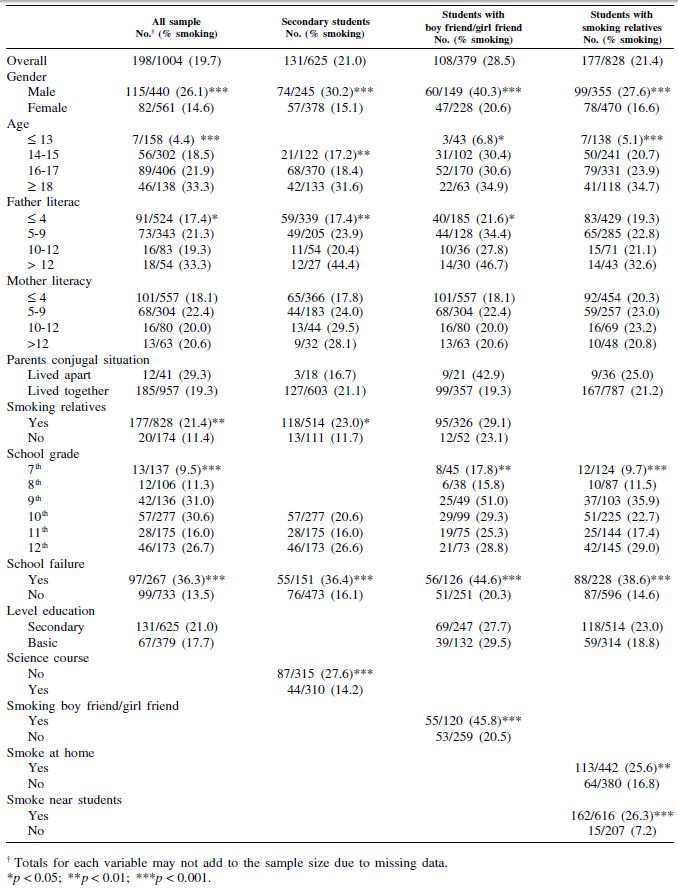
Table 1 shows the prevalence of smoking, by social, demographic, and behavioural characteristics among adolescents. The overall smoking prevalence rate in this sample was 19.7% with boys more likely to smoke than girls (p < 0.001). Smoking was also associated with age, father literacy, relatives’ smoking habits, academic performance and school grade. The prevalence of smoking increased with age, father literacy level, relatives’ smoking and with low academic performance.
When the findings were adjusted for variables that presented a significant univariable association with smoking, age was no longer significantly associated with higher risk of smoking (Table II).
Table II
Adjusted odds ratio of smoking, according to social and behavioural characteristics
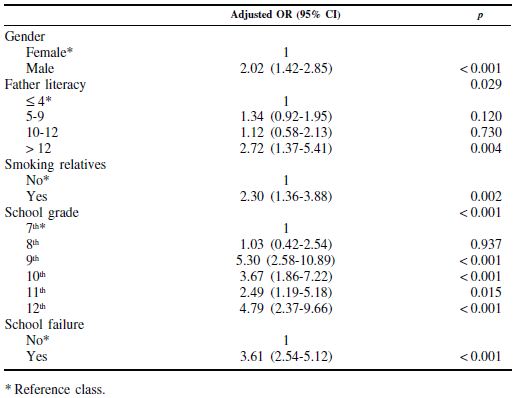
3.2. Students in the secondary grade
Table III gives results of the multivariable modelling for the group attending a secondary level course. In this group, our results showed that smoking was independently associated with gender, father’s literacy, having smokers among the relatives, school failure and belonging to a science-course. This analysis shows an important and significant association between belonging to non-sciencecourses and higher risk of smoking (OR = 1.81; 95% CI: 1.18, 2.78; p = 0.007).
Table III
Adjusted odds ratio of smoking, according to social and behavioural characteristics, among secondary students
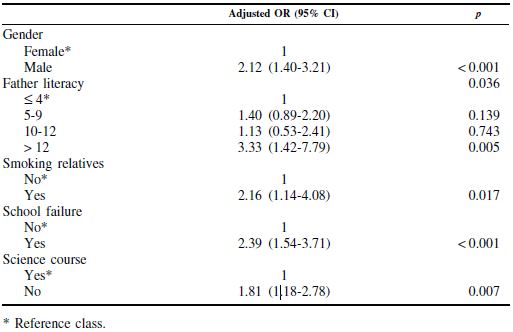
3.3. Students with a romantic relationship
Among all the adolescents inquired, a considerable percentage, 38.0% (380/1000), had a romantic relationship. Among these, 60.6% (229/378) were girls (Table I). In this sub sample there is a higher consumption of tobacco, 28.5% instead of the 19.7% found in the global sample. The proportion of smokers among the students having a boyfriend/ girlfriend who smokes is more than twice the proportion among the ones having a partner that doesn’t smoke (45.8% and 20.5%, respectively).
Among the possible predictor variables included in the multifactorial model four factors remained significantly associated with smoking (Table IV), gender, school grade, school failure and having a boyfriend/girlfriend who smokes. A significant interaction (p = 0.016) was also found between school failure and having a boyfriend/girlfriend who smokes. Having a boyfriend/girlfriend who smokes has a strong influence in smoking (OR = 5.44; 95%CI: 2.40, 12.32; p < 0.001), increased when the adolescent suffer school retention.
Table IV
Adjusted odds ratio of smoking, according to social and behavioural characteristics, among students with boyfriend/girlfriend
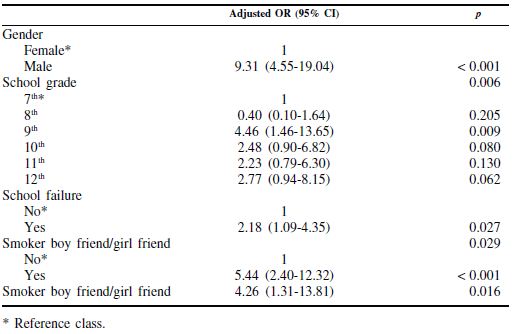
3.4. Students with smoking relatives
Using univariable analysis (Table I) in the group of students with smokers among their relatives, smoking was significantly and positively associated with the following variables: gender, increasing age, school grade, low academic performance, having parents who smoke near the student and having parents who smoke at home. There is a considerable percentage of the adolescents exposed to tobacco smoke by their relatives: 44% (442/1005) and 61% (616/1005) report having relatives who smoke at home and near them, respectively.
When the logistic regression method was applied to determine the set of factors that are independently associated with smoking (Table V), the variables having parents who smoke at home and age were no longer statistically significant.
Table V
Adjusted odds ratio of smoking, according to social and behavioural characteristics, among students with smokers among their relatives
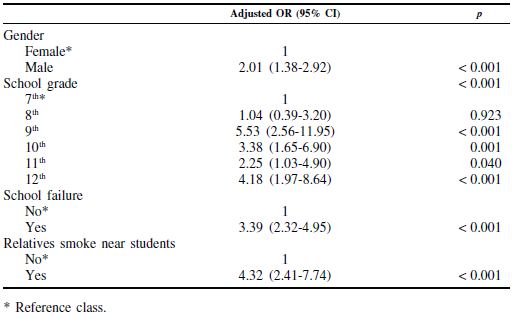
Students who had parents who smoked near them had about four times more chances of smoking than students whose parent’s hadn’t these behaviour (OR = 4.32; 95% CI: 2.41, 7.74; p < 0.001).
4. Discussion
The current survey was done as a cross-sectional study that in spite of not representing the entire Portuguese population may contribute to understand adolescents’ attitude and smoking behaviours. The cross-sectional study has the advantage of giving information quickly and at a low cost. A shortcoming needs to be considered, given the cross-sectional study design; evidence of an association should be interpreted with some caution before a causal relation is claimed. In Portugal some surveys (Machado, Barros e Vicente, 1995; Azevedo, Machado e Barros, 1997; Carvalho, 1997) have used cross-sectional studies among students.
In this study the prevalence of cigarette smoking was examined in a sample of high-school students in a suburban area of District of Porto. Data collection took place during three consecutive days with the aim of avoiding crossed answers. The fact that missing students didn’t answer the questionnaire may have contributed to change the final results; nevertheless these students don’t seem to have different characteristics from the others. Data was collected through a non standardized questionnaire although its questions have a valid content (Hill e Hill, 2002; Pereira, 1995). The questionnaire was well accepted because there were no refusals in participating. Another shortcoming needs to be considered, since the reported smoking status was not confirmed by means of cotinine or carbon monoxide measurements, there could be underreporting. However, a review and meta-analysis produced by Patrick et al. (1994) showed that data collected from adolescents by self-reporting are reliable and, once the confidentiality of the data is assured, it can be accepted as valid.
The present study showed that factors belonging to different levels of analysis — family, school, peer relations — make independent contributions towards characterization of the smoking behaviours among adolescents: gender, relatives’ smoking status, relatives’ smoking behaviours, boyfriend/girlfriend’ smoking status, academic performance and scientific course. These factors seem to produce vulnerabilities for smoking.
Overall, 19.5% of students were current smokers. It is not easy to compare the finding with those from other studies owing to different criterions to define smoking status and age groups. Prevalences were close to other Portuguese studies (Azevedo, Machado e Barros, 1997; Carvalho, 1997; Hill e Hill, 2002; Pereira, 1995; Patrick et al., 1994; Rodrigues, Antunes e Mendes, 1994) and lower than a study in a large sample of high-school students from different Portuguese continental districts (Machado, Barros e Vicente, 1995). In Malcon, Menezes e Chatkin (2003) study, it was found a diversity of prevalences. Analyses felt upon the general sample and three subsamples with the aim of analysing factors belonging to different levels: family, school and peer relations. In all our samples gender and academic performance were associated with current smoking among adolescents. Male were significantly more likely to smoke than female, as in other researches (Carvalho, 1997; Barbosa, Carlini-Cotrim e Silva-Filho, 1989; Yang et al., 1999). In a systematic study achieved in South America, Malcon et al. (2003) also showed that a lot of studies had followed this tendency. These findings may be consistent with the social role associated with masculine gender chiefly because participants in this study were living in an area with some rural characteristics. A low academic performance appears to be a risk factor for smoking. This observation is in accordance with results of many studies (Azevedo, Machado e Barros, 1997; Malcon, Menezes e Chatkin, 2003; Azevedo et al., 1999). When the finding was adjusted to the other variables in a logistic regression model students who failed at school were almost approximately two to three times more likely of smoking than those who have never failed.
The prevalence of smokers increases with age and school grade, however the multivariable analyses showed that only school grade was independently associated with the risk of smoking. This evidence may suggest that social relation between groups of students that were in the same school grade is a strong predictor for smoking. Amazingly, as the students grow up and have more conception about the risk, prevention and are more aware of the tobacco use, they tend to smoke with more frequency. This fact can be explained because the beginning of smoking and the maintenance of this behaviour among young people is associated with a great number of factors.
Results from this study suggest belonging to a science course protect adolescents from smoking. Perhaps the students of this course had more information about health and deleterious tobacco effects.
The peers influence was evaluated in the adolescents having a romantic relationship. In these adolescents having a boyfriend/girlfriend who smokes is related to higher rates of smoking. The strength of this relation increased when there is an history of school failure.
Another important risk factor is the smoking behaviours of relatives (Gritz et al., 2003; Gliksman et al., 1989; Scragg, Laugesen e Robinson, 2003).
Our results showed an important association between parent’s behaviours and a significantly higher risk to smoke. In the general sample, students who had at least one smoker among their relatives had a higher risk of smoking relatively to those who hadn’t. In the students group with smokers among their relatives, we found an alarming data, adolescents who had relatives who smoked near them were four times more likely to smoke compared with the others who hadn’t relatives with this behaviour. The presence of an adult tobacco user at home influences smoking among adolescents, providing a negative role model for them. Thus, preventive tobacco programmes should be created involving not only young people, but also their family and peers.
According to the results, at least 61% of the students are second hand smokers, since they report having relatives who smoke near them.
In the general sample and in the group of the secondary grade, the risk of smoking was higher among students with fathers who had a high educational level. Maybe, these parents will be those who had a better economic situation and consequently give them a higher monthly allowance for the young to buy cigarette packages.
The prevalence of tobacco smoking has a worrying dimension mainly in what concerns adolescents. In this behaviour are involved environment factors which are changeable and this is a problem that must be considered as a priority by health professionals and health services. The knowledge about the smoking determinants, the behaviours and the opinion of youngest about preventive tobacco measures enables us to direct measures and evaluate them precisely with a better financial and technical income in this way.
The tobacco control and nicotine addiction is based on the combination legislation-education. This combination will only be effective when used in a global way with a whole governmental action, coordinated by all countries as world plan.
While making part of this reality, school is seen as an important factor of influence for young people because it is an important place where knowledge can be built in interactively, contributing to volunteer and conscious actions resulting in healthy behaviours. School distinguishes itself from other institutions when offering the possibility of educating through knowledge construction. Knowledge brought by students and their relatives, expressing unique beliefs and values; scientific knowledge given by different school subjects; knowledge given by the media, most of the times divided and without connection, but important because of it’s crucial social-cultural influence. To add to these knowledge we have those brought by teachers with theirs own experience and personal and professional life, that will be recognized as a role model by students. School must be a fundamental way of developing educational actions for health in general and specifically those which contribute to control tobacco smoking.
Even if this work can’t answer many of the questions related to young people’s habits, attitudes and behaviours this may effectively contribute to moments of reflection and motivation for future works as well as being an incentive to conduct actions by the school population to create a school free from tobacco.
Acknowledegements
The authors are grateful for the administration of the High School of Lousada for their collaboration and cooperation with this study. This study would not been possible without the generosity of the students who participated in this research. The authors would like to thank Mrs Alzira F. Silva for English correction.
References
AZEVEDO, A.; MACHADO, A. P.; BARROS, H., 1997 — Prevalência do consumo de tabaco e bebidas alcoólicas, café e drogas de abuso em adolescentes no Porto. Arquivos de Medicina. 14 (1997) 49-64.
AZEVEDO, A. et al. — Tobacco smoking among Portuguese high-school students. Bulletin of the World Health Organization. 77 : 6 (1999) 509-514.
BARBOSA, M. T. S.; CARLINI-COTRIM, B.; SILVA-FILHO, A. R. — O uso de tabaco por estudantes de primeiro e segundo graus em dez capitais brasileiras : possíveis contribuições da estatística multivariada para compreensão do fenómeno. Revista de Saúde Pública. 23 : 5 (1989) 401-409.
CARVALHO, N. J. — Consumo de álcool e drogas nos jovens : estudo epidemiológico no Conselho de Matosinhos. Matosinhos : Contemporânea, 1997.
ELDERS, M. J. et al. — The report of the surgeon general : preventing tobacco use among young people. American Journal of Public Health. 84 : 4 (1994) 543-547.
GLIKSMAN, M. D. et al. — Cigarette smoking in Australian schoolchildren. The Medical Journal of Australia. 150 : 2 (1989) 81-84.
GRITZ, E. R. et al. — Predictors of susceptibility to smoking and ever smoking : a longitudinal study in a triethnic sample of adolescents. Nicotine & Tobacco Research. 5 : 4 (2003) 493-506.
HILL, M. M.; HILL, A. Investigação por questionário. 2ª ed. Lisboa : Edições Sílabo, 2002.
MACHADO, A. P.; BARROS, H.; VICENTE, P. — Adolescentes fumadores em escolas portuguesas. Saúde em Números. 10 : 13 (1995) 17-19.
MALCON, M. C.; MENEZES, M. A. B.; CHATKIN, M. — Prevalência e factores de risco para o tabagismo em adolescentes. Revista de Saúde Pública. 37 : 1 (2003) 1-7.
MALCON, M. C. et al. — Prevalência e fatores de risco para tabagismo em adolescentes na América do Sul : uma revisão sistemática da literatura. Revista Panamericana de Salud Pública. 13 : 4 (2003) 222-228.
ORLEANS, C. T.; SLADE, J. — Nicotine addiction : principles and management. Oxford : Oxford University Press, 1992.
PATRICK, D. L. et al. — The validity of self-reported smoking : a review and meta-analysis. American Journal of Public Health. 84 : 7 (1994) 1086-1093.
PEREIRA, G. M. — Epidemiologia, teoria e prática. São Paulo : Guanabara Koogan, 1995.
PETO, R. et al. — Mortality from smoking in developed countries 1950-2000 : indirect estimates from national vital statistics. Oxford : Oxford University Press, 1994.
POKORNY, S. B.; JASON, L. A.; SCHOENY, M. E. — Current smoking among young adolescents : assessing school based contextual norms. Tobacco Control. 13 : 3 (2004) 301-307.
RODRIGUES, L. M.; ANTUNES, C., MENDES, Z. — Droga meio escolar : perfis regionais e risco. Lisboa : Gabinete de Planeamento e Coordenação do Combate à Droga, 1994.
SCRAGG, R.; LAUGESEN, M.; ROBINSON, E. — Parental smoking and related behaviours influence adolescent tobacco smoking : results from the 2001 New Zealand national survey of 4th form students. New Zealand Medical Journal. 116 : 1187 (2003) 1-14.
YANG, G. et al. — Smoking in China : finding of the 1996 National Prevalence Survey. JAMA. 282 : 13 (1999) 1247-1253.
Submetido à apreciação: 29 de Maio de 2008
Aceite para publicação: 28 de Junho de 2009













